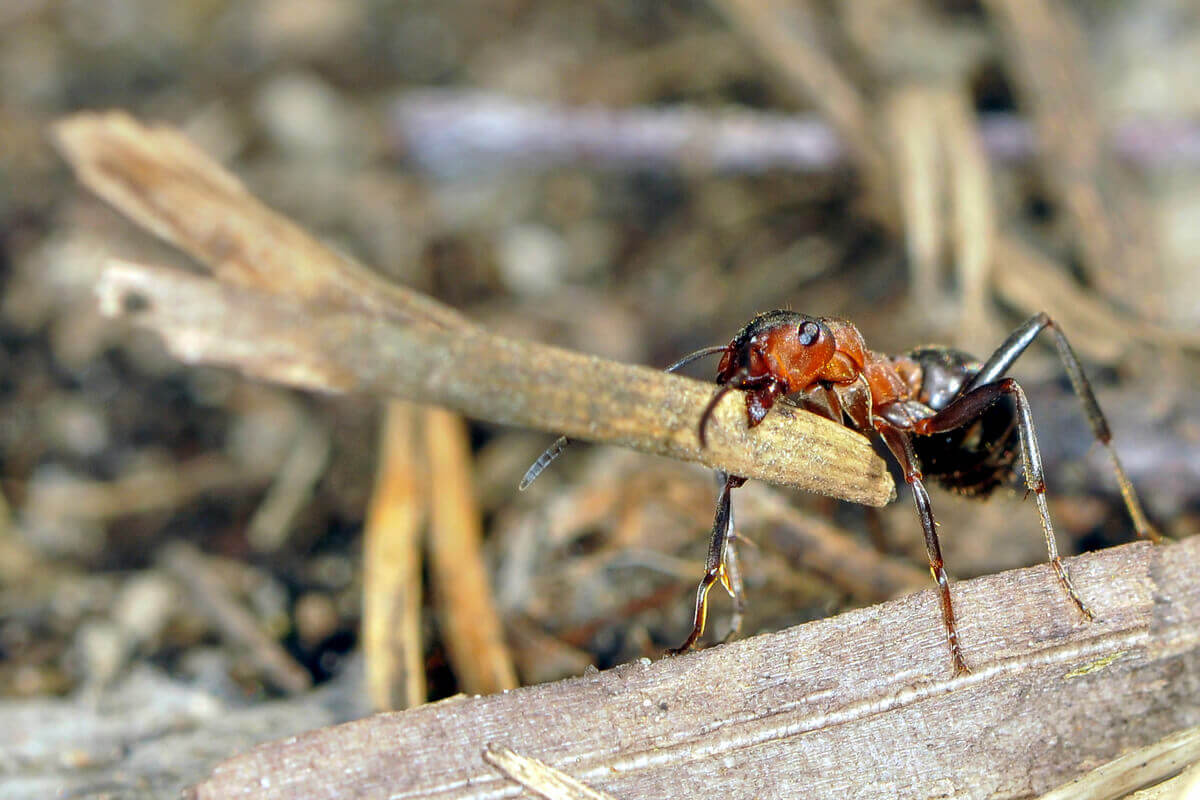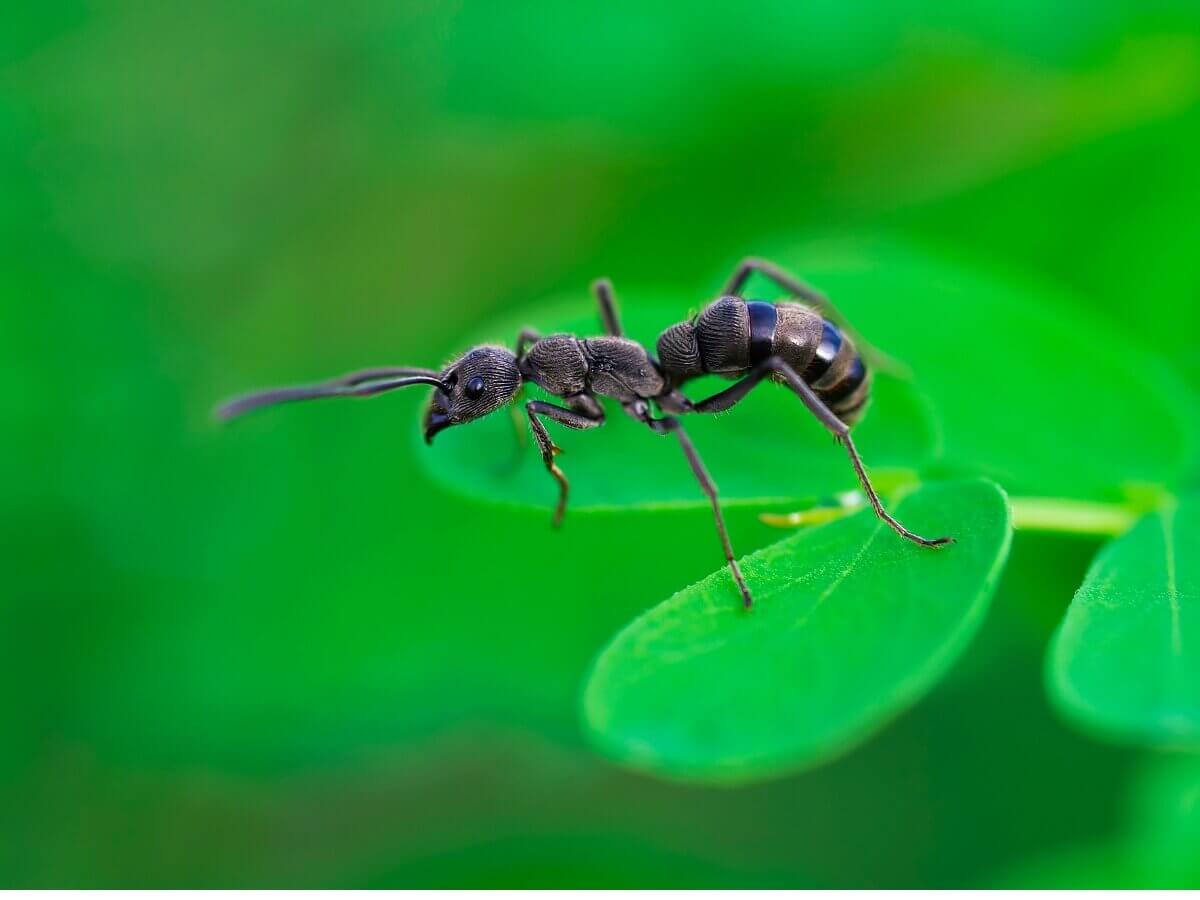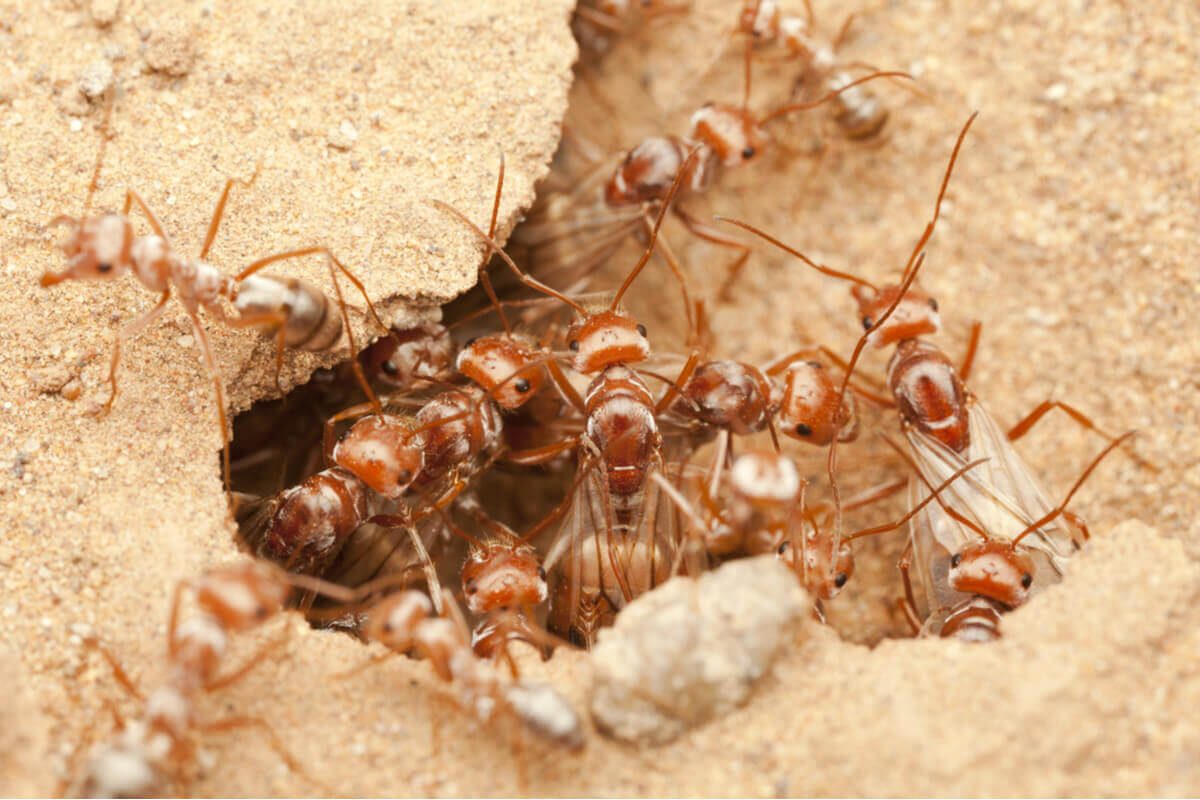The Behavior of Ants


Written and verified by the biologist Samuel Sanchez
Ants are a family of insects (Formicidae) that, together with bees and wasps, form the order Hymenoptera. To date, scientists have recorded more than 22,000 species – of which they’ve described 13,800. And, according to estimates, they account for up to 25% of the terrestrial biomass of animal origin. Do you want to know more about the behavior of ants?
These invertebrates stand out for their unusual eusociality and the formation of superorganisms. In other words, they’re capable of creating complex structures that go far beyond the sum of each of the members. Hymenopterans undoubtedly represent a fascinating evolutionary strategy and we still have a lot to learn about them.
The characteristics of ants
Ants are Hymenoptera, but they also belong to the class Insecta. As insects, they have a series of characteristics that they share with grasshoppers, beetles, mantises, and others, such as a body that consists of a head, thorax, and abdomen, 6 limbs, and the presence of very notable cephalic antennae.
Like other insects, ants have an exoskeleton that protects them from the environment. In this case, it consists of an epicuticle and a chitinous procuticle. In addition, it’s important to note that they don’t have lungs and airways to use. Rather, oxygen enters their body through the exoskeleton through pores called spiracles.
At the cephalic level, these invertebrates are highly developed. They have a pair of lateralized compound eyes, 3 ocelli on the top of the head – which detect light levels and polarization – and a pair of antennae, capable of registering chemicals, air currents, and vibrations. As we’ll see later on, these are essential in communication.
The thorax or mesosome contains the 6 motor extremities and the wings, present in queens and males at the time of reproduction. At the same time, the abdomen or metasoma protects all the vital organs of the animal, including the reproductive, respiratory, and excretory systems. Interestingly, some species have modified reproductive organs like stingers.
Each species of ant has its own characteristics, but all of them follow a common general body plan.

The behavior of ants
As we’ve said, there are records of more than 22,000 species of ants in the world. Establishing generalities in such a broad taxon is a daunting task. However, the existence of common ancestors and evolutionary convergence have made some traits applicable to almost all formicids. We’ll give you some examples:
- The behavior of ants is governed by mechanisms of kin selection.
- There’s competition between individuals of the same species and population, between populations (colonies), and between species.
- The colonies show hierarchies in the colony control processes. The competition between members of the same colony shapes the dynamics of the community.
- The colonies differentiate into castes, generally workers, soldiers, queens, and males.
- Castes have been shaped by natural selection in order to maximize the biological fitness of the entire colony, rather than each individual individually.
In addition to the dynamics of the colonies, ants often have obligate relationships with certain species of plants and invertebrates. They’re essential for the maintenance of the biogeochemical cycles of soils, an excellent source of protein for various species. What’s more, they play an unrivaled role in seed dispersal, among other things.
Here, we’ll explore some of the behaviors of ants. From kin selection to eusociality, you’ll be amazed.
Castes in the anthill
In general, experts claim that ants divide their colonies into castes. However, this line becomes a bit blurry in some species. Just the same, we can point out the following social organizations in the anthill:
- The queen: She’s the pillar of the colony, the “heart” and the “brain” at the same time. When the queen reproduces with a winged male, she buries herself and begins to lay eggs, which will correspond to future workers. A queen ant can live up to 30 years, depending on the species. It’s diploid (2n), simply put, it has a complete “genetic picture”.
- Workers: The workers are the “hands” of the colony. They usually live from 1 to 3 years and carry out all the tasks of the anthill, from the construction of galleries to the search for food. According to studies, the differentiation from worker to queen could depend on nutritional intake in the larval stage. They’re also diploid (2n).
- Males: Males are spermatic sacs with legs, as their only purpose is to reproduce and die. It’s important to note that they’re haploid (n) living beings, which means that they have half the genetic information of females and workers – a single set of chromosomes.
However, this rule isn’t true in all ants. Some species present organizations in which all workers are potentially reproductive, but one or a group is selected above the rest by dominance mechanisms (Gamergate). Diacamma rugosum is an excellent example of this.

Ants and the kin selection
To put it quickly and simply, kin selection attempts to explain “altruism” in the animal kingdom. That is, why there are living beings that help their relatives even if this involves a considerable energy investment for them. This postulation starts from the Hamilton equation:
rB> C
(r) represents the genetic relationship between both components of the dynamics, (B) the benefit obtained by the one who performs the altruistic behavior, and (C) the reproductive cost that the behavior entails in order to help the benefactor. In other words, the greater the kinship between animals (r), the more likely it is that a specimen from the colony will help its relative or “superior”.
We can also apply this theory to Hymenopterans, especially ants. The workers “renounce” their reproductive capacity to favor that of the queen, as it’s “worth it” at an evolutionary level, as they’re all very close relatives. This strategy favors the spread of common genes between generations rather than individual reproduction.
Despite the interestingness of these theories, not all ant behavior can be explained by kin selection. Many professionals questions these postulations to date.
The behavior of ants as eusocial and cooperative beings
Whether by kin selection or other mechanisms, ants are a clear example of extreme eusociality. In these inseparable communities, the adults belong to 2 or more overlapping generations, they take care of the offspring in a cooperative way, and the vast majority of the members aren’t capable of reproducing themselves (workers).
In these colonies, natural selection doesn’t act on the individual, but on the entire population as a whole. So, all the members cooperate with each other in an extreme way. For this reason, if the hierarchy or the social structure breaks, the entire colony collapses. In other words, if the queen dies, the workers die with her – except for the Gamergates mentioned above.
In the anthill, the life of the worker isn’t relevant. It’s sacrificed without problem if it saves the larvae or the queen.
Ants as superorganisms
As we’ve said before, each ant colony is a complex organism that supposes something “beyond” the sum of all its parts. All superorganisms share the following characteristics:
- The components of the colony live in a common structure (anthill or nest) that provides protection to the queen and larvae and allows the provision of food. The temperature and humidity of the nests are unique for each species and its components can modulate it.
- The queen or mother is the “heart” and “brain” of the superorganism. It can live up to 100 times longer than expected for its size and morphology.
- The members of the colony share functions. Some of them take care of the larvae, others hunt, and others build tunnels and keep the anthill clean.
All of these complex interactions bring a host of vast benefits. Ants produce a greater number of offspring than the average insect, live much longer as a biological unit, and are capable of maintaining a certain independence from the external environment.
A very clear example of this unitary complexity is represented by the species Myrmecocystus mexicanus. In these anthills, a selected group of workers feed on and fill their gaster — the bulbous portion of the metasoma — to physiological limits. Then they hang from the ceiling of an anthill cell, become immobile, and act as living food stores.
Communication
Gatherer ants travel distances of up to 200 meters from the nest. Thanks to their antennas, they are capable of detecting the pheromones emitted by other members of the colony, and thus they arrive safely back to their population nucleus. These trails are also useful for marking food sources, hazards, other colonies, and much more.
Beyond this, some diurnal species in arid environments – such as Cataglyphis bicolor – are able to orient themselves in different ways. As studies indicate, this species has a kind of “pedometer” and the workers count the steps they’ve taken from the anthill to a specific destination. They also use as reference objects in the environment and the position of the Sun.

The eating behavior of ants
In general, we usually have the idea of an ant collecting seeds and small debris to feed itself, but not all formicids follow this strategy. Some species feed on fungi that they grow in their anthills (Acromyrmex) and others are practically strict carnivores (Odontomachus, harpegnathos, and myrmecia, among others).
The clearest example of the predatory strategy is the trap-jaw, especially those belonging to the genus Odontomachus. This group has the second-fastest predatory appendages in the animal kingdom, as they’re capable of closing their jaws in an average of 130 microseconds, as studies indicate. Together with their stinger capable of secreting toxins, this turns them into killing machines.
Finally, we can’t forget the ants of the genus Myrmecia, also known as bull ants in their habitat (Australia). The 93 species included in this taxon are noted for their powerful jaws, excellent sense of sight, and powerful toxins. Although they’re not lethal to humans, deaths from anaphylactic shock have been detected.
Most ant species are scavengers, generalist predators, or direct herbivores. However, some have developed very specialized eating strategies.
Final notes on the behavior of ants
As you may have noticed, the world of ants goes far beyond the invasion of picnics during spring or summer. Some ants live in trees and their larvae produce silk ( Polyrhachis dives), others cultivate fungi on which they feed (Atta and Acromyrmex) and others tirelessly hunt large prey (Myrmecia).
If something’s clear to us after these lines, it’s that ants have a lot to teach us when it comes to evolution and complex societies. Without a doubt, they’re the living example that unity is strength.
All cited sources were thoroughly reviewed by our team to ensure their quality, reliability, currency, and validity. The bibliography of this article was considered reliable and of academic or scientific accuracy.
- André, J. B., Peeters, C., Huet, M., & Doums, C. (2006). Estimating the rate of gamergate turnover in the queenless ant Diacamma cyaneiventre using a maximum likelihood model. Insectes sociaux, 53(2), 233-240.
- Formicidae, ADW. Recogido a 25 de junio en https://animaldiversity.org/accounts/Formicidae/
- Wittlinger, M., Wehner, R., & Wolf, H. (2006). The ant odometer: stepping on stilts and stumps. science, 312(5782), 1965-1967.
- Czaczkes, T. J., & Ratnieks, F. L. (2013). Cooperative transport in ants (Hymenoptera: Formicidae) and elsewhere. Myrmecol. News, 18, 1-11.
- Patek, S. N., Baio, J. E., Fisher, B. L., & Suarez, A. V. (2006). Multifunctionality and mechanical origins: ballistic jaw propulsion in trap-jaw ants. Proceedings of the National Academy of Sciences, 103(34), 12787-12792.
- Wilson, E. O., & Hölldobler, B. (2005). Eusociality: origin and consequences. Proceedings of the National Academy of Sciences, 102(38), 13367-13371.
This text is provided for informational purposes only and does not replace consultation with a professional. If in doubt, consult your specialist.